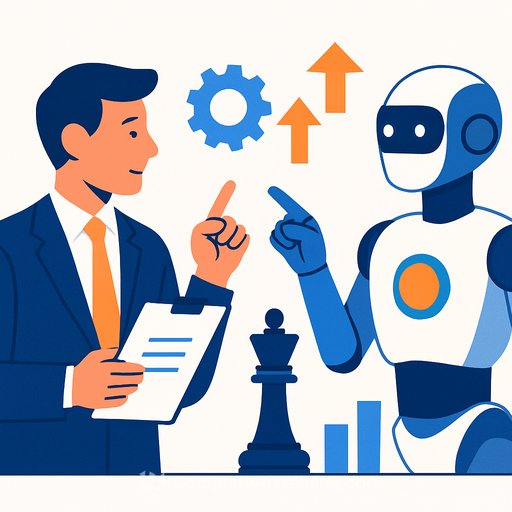Three Things Frontier Firms Know About AI (Product Teams, Take Note)
AI is moving from pilots to real work. The teams pulling ahead are human-led and agent-operated. They're rebuilding processes, not layering bots on top of broken workflows.
If you lead product, the challenge isn't picking tools. It's making work visible, designing with AI as infrastructure, and turning experimentation into a repeatable practice.
1) Make the invisible visible
Most information work happens offstage. Threads, comments, handoffs, and "quick checks" disappear into calendars and inboxes. If you can't see it, you can't fix it.
Frontier Firms treat workflows like systems. They map every step, log every handoff, and measure latency where work actually stalls-approvals, reviews, data pulls, vendor replies.
Example: A finance platform traced each step across expense management, AP, and procurement. Tiny delays added up to weeks. By deploying agents to match receipts and verify approvals, they now process millions of receipts monthly and close faster, reclaiming thousands of hours. The impact came from mapping the work first, then inserting AI where it removes friction.
- Instrument the flow: Track start/stop events, queue time, review time, and rework. Treat an "idea → shipped" path like a pipeline.
- Define units of work: PRs, tickets, test runs, legal clauses, vendor steps. Make them measurable.
- Expose bottlenecks: Where do tasks wait? Who or what is the blocker? What does each delay cost?
- Deploy narrow agents: Classification, matching, enrichment, verification. Start with high-volume, low-risk steps.
2) Think of AI as infrastructure
AI isn't a demo to show investors. It's part of the product development stack-like source control, CI/CD, and observability. When AI sits inside the flow of work, cycle time drops and quality rises.
At LinkedIn, product, design, and engineering work in full-stack pods from idea to launch. An internal agent (Mae) fixes a significant share of developer builds automatically. People still set direction and review quality, but they span research, design, coding, testing, and release with AI helping at each step.
- Design with AI: Add "AI surfaces" to every spec-what to automate, what to assist, and where humans make final calls.
- Platformize agents: Provide a shared runtime, policies, evaluation harnesses, and observability for agent tasks.
- Wire into CI/CD: Agents propose tests, patch flaky ones, fix builds, and draft docs. Humans approve with clear gates.
- Enable safe data access: Central retrieval, permissions, and audit trails. No ad-hoc data plumbing per team.
- Measure outcomes, not usage: Track lead time for changes, change failure rate, deployment frequency, and MTTR. Consider the DORA framework for benchmarking cycles and quality here.
3) The frontier is a practice, not a place
There's no finish line. Frontier Firms run structured experiments with clear metrics and governance. Curiosity is great; controlled iteration is better.
One financial services company set a simple goal: improve client service with AI. Teams mapped their core journeys, broke big tasks into smaller ones, automated prep for junior staff, and freed senior staff to focus on client conversations. Training, incentives, and transparent dashboards kept everyone aligned.
- Standardize experiments: Hypothesis, guardrails, sample size, acceptance criteria, rollout plan. Keep trials small and fast.
- Establish governance: Risk tiers by use case, model and data approvals, and red-team reviews. The NIST AI Risk Management Framework is a solid starting point here.
- Close the loop: Log agent actions, track error types, and feed learnings back into prompts, policies, and training.
- Realign roles: Juniors prep with AI; seniors handle decisions and exceptions. Reward outcomes, not hours.
What product leaders can do this quarter
- Weeks 0-2: Pick one core flow (e.g., spec → PR → release). Instrument wait states. Baseline cycle time, review time, and defect rates.
- Weeks 3-6: Ship two agents that remove obvious friction (build fixes, test generation, requirements checking). Add human-in-the-loop approvals.
- Weeks 7-10: Expand to adjacent steps (release notes, customer comms drafts, changelog summaries). Track net time saved and quality deltas.
- Weeks 11-12: Review metrics, retire weak agents, harden strong ones, document the pattern, and templatize for other pods.
- Metrics to watch: PR lead time, queue time per step, change failure rate, escaped bugs, agent adoption rate, and hours saved vs. baseline.
Bottom line
Frontier Firms don't bolt AI onto old habits. They rebuild the way work gets done: make the invisible visible, treat AI as part of the stack, and run experiments with real guardrails.
Do that, and AI stops being a shiny add-on and starts compounding product velocity and business performance.
Need to upskill your team?
If you're building out product, design, or engineering skills for this shift, explore role-based learning paths here.
Your membership also unlocks:






